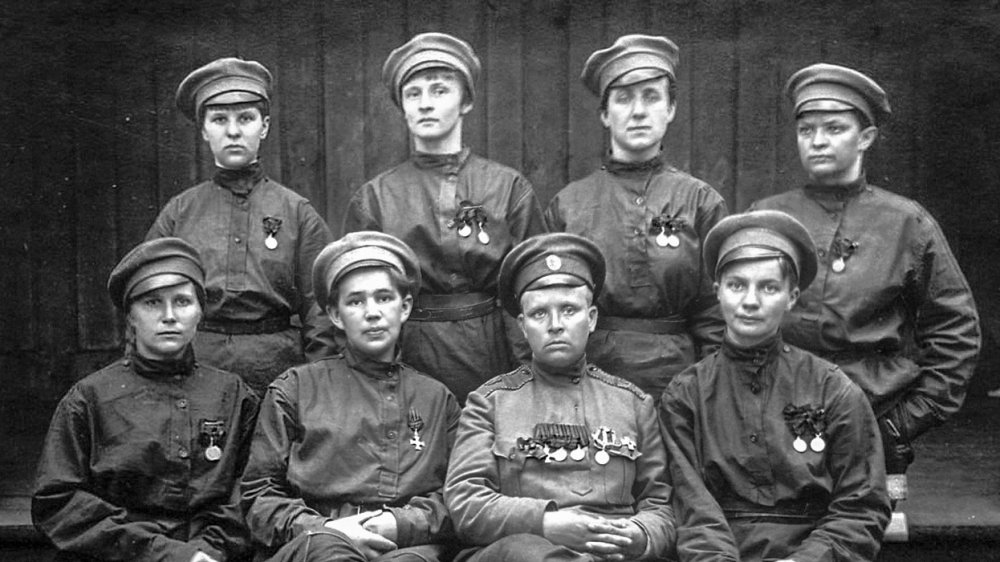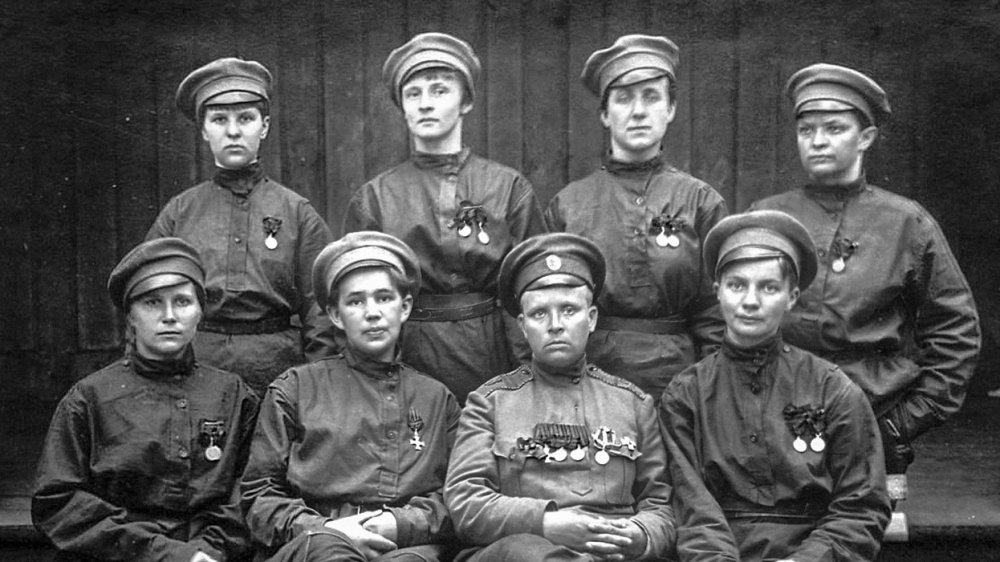É difícil comentar sobre a Primeira Guerra Mundial sem citar todas as mudanças sociais em relação às mulheres que aconteceram durante esse período. Com milhões de homens longe das indústrias devido à guerra, as mulheres as ocuparam, o que certamente redefiniu seu espaço na sociedade moderna.
Algumas mulheres também viram serviço nas batalhas, como motoristas de veículos, operadoras de telefone e, mais importante, como enfermeiras. Mas, mesmo assim, não era comum ver essas mulheres na frente de batalha, exceto por alguns casos raros.
Um deles era o de Maria Bochkareva, mulher nascida na pequena região de Nikolsky, na Rússia. Em 1914, com o começo da Primeira Guerra Mundial, ela viajou à cidade de Tomsk para se voluntariar ao exército Russo, mas não foi aceita, devido ao fato de que era uma mulher. Sem perder esperança, Maria enviou um telegrama para o próprio Czar Nicolau II, pedindo que fosse aceita para o exército. Nicolau aceitou o pedido.
Bochkareva era forte e destemida, e não encontrava problema em raspar seu cabelo como os demais recrutas. Durante o período de 1914-1916, ela lutou diretamente na frente contra a Alemanha, até a Revolução de Fevereiro de 1917.
Inicialmente uma apoiadora da Revolução, ela ficou decepcionada com a falta de ordem no exército que essa trouxe. Muitos homens desertaram a frente em 1917, e, devido a isso, foi permitida a criação de “batalhões da morte” russos, feitos para aumentar a moral dos soldados, mostrando que eles eram homens totalmente capazes de lutar pela nação.
A Maria foi garantida a permissão de Alexander Kerensky, ministro de guerra na época, para criar seu próprio batalhão, composto apenas de mulheres, visando que isso iria causar uma vergonha imensa para os homens, revivendo a moral do exército.
O batalhão foi levado como reforço ao exército principal da frente alemã em Julho de 1917, mas após 5 dias de combate, a maioria dos soldados estava morto ou ferido. Bochkareva foi acertada por artilharia, e foi levada à Petrogrado.
Após a Revolução de Outubro, o batalhão foi dissolvido e Maria foi capturada 2 vezes pelos bolcheviques. Em exílio, recebeu suporte do Rei Inglês Jorge V para desfazer a revolução, mas, voltando à Rússia, não conseguiu montar um exército, e foi capturada e executada em 1920.

Maria Bochkareva
It is difficult to talk about the First World War without commenting on all the social changes made in favor of women. With millions of men far from the industries because of the war, women started to occupy them, which certainly redefined their place in our modern society.
Some women also saw service in the battles, as vehicle drivers, telephone operators and, more commonly, as nurses. Still, except for a few instances, it was not common to see women on the frontlines.
One of these instances was that of Maria Bochkareva, a woman born in the small region of Nikolsky, Russia. In 1914, with the start of WW1, she traveled to Tomsk to volunteer for the Russian Army, but she was denied her role because she was a woman. Without losing hope, Maria sent a telegram to Tsar Nicholas II, asking to be put into the army. Nicholas accepted her request.
Bochkareva was strong and fearless, and didn’t see any problem in shaving her hair like the other male recruits. From 1914 to 1916, She was deployed on the frontline against Germany until the start of the February Revolution in 1917.
Initially a supporter of the revolution, she was disappointed with the lack of order in the military the Mensheviks brought. Many men deserted the front in 1917, and, because of that, many russian “death battalions” were created, these made to boost the army morale, showing that all men were capable of fighting for the Motherland.
Alexander Kerensky, minister of war at the time, granted Maria permission to create her own death battalion, made solely of women, seeing this would cause major shame in the men who had deserted, reviving the Army’s morale.
The battalion, made of around 300 women, was deployed on the German front in July 1917, but after 5 rough days of combat, the majority of the soldiers were either dead or wounded. Hit by an artillery shell, Bochkareva was taken to Petrograd to get her promotion to the rank of lieutenant.
After the October Revolution, the battalion was disbanded and Maria was captured twice by the Bolsheviks. In exile, she received support from English King George V to dissolve the revolution, but, upon her return to Russia, her efforts were in vain, and her story came to a tragic end, when she was captured for the third time and executed by a firing squad.
Autores: Arthur Chemim, Fabrício Bach Czelusniak, Francisco Galvão Coloda
Fonte da imagem: https://www.grunge.com/175489/the-untold-story-of-russias-all-female-battalion-of-death/ Acesso em: 25 de Maio de 2021

